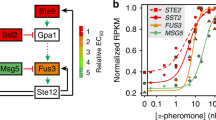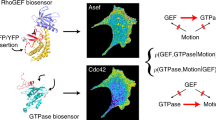Abstract
Signal transduction through mitogen-activated protein kinase (MAPK) cascades is thought to occur through the assembly of macromolecular complexes. We quantified the abundance of complexes in the cytoplasm among the MAPKs Ste11, Ste7, Fus3 and the scaffold protein Ste5 in yeast pheromone signalling using fluorescence cross-correlation spectroscopy (FCCS). Significant complex concentrations were observed that remained unchanged on pheromone stimulation, demonstrating that global changes in complex abundances do not contribute to the transmission of signal through the cytoplasm. On the other hand, investigation of the distribution of active Fus3 (Fus3PP) across the cytoplasm using fluorescence lifetime imaging microscopy (FLIM) revealed a gradient of Fus3PP activity emanating from the tip of the mating projection. Spatial partitioning of Fus3 activating kinases to this site and deactivating phosphatases in the cytoplasm maintain this Fus3PP-activity distribution. Propagation of signalling from the shmoo is, therefore, spatially constrained by a gradient-generating reaction-diffusion mechanism.
This is a preview of subscription content, access via your institution
Access options
Subscribe to this journal
Receive 12 print issues and online access
$209.00 per year
only $17.42 per issue
Buy this article
- Purchase on Springer Link
- Instant access to full article PDF
Prices may be subject to local taxes which are calculated during checkout





Similar content being viewed by others
References
Dohlman, H. G. & Thorner, J. W. Regulation of G protein-initiated signal transduction in yeast: paradigms and principles. Annu. Rev. Biochem. 70, 703–754 (2001).
Inouye, C., Dhillon, N. & Thorner, J. Ste5 RING-H2 domain: role in Ste4-promoted oligomerization for yeast pheromone signaling. Science 278, 103–106 (1997).
Garrenton, L. S., Young, S. L. & Thorner, J. Function of the MAPK scaffold protein, Ste5, requires a cryptic PH domain. Genes Dev. 20, 1946–1958 (2006).
Winters, M. J., Lamson, R. E., Nakanishi, H., Neiman, A. M. & Pryciak, P. M. A membrane binding domain in the ste5 scaffold synergizes with gβγ binding to control localization and signaling in pheromone response. Mol. Cell 20, 21–32 (2005).
van Drogen, F., Stucke, V. M., Jorritsma, G. & Peter, M. MAP kinase dynamics in response to pheromones in budding yeast. Nature Cell Biol. 3, 1051–1059 (2001).
Cook, J. G., Bardwell, L., Kron, S. J. & Thorner, J. Two novel targets of the MAP kinase Kss1 are negative regulators of invasive growth in the yeast Saccharomyces cerevisiae. Genes Dev. 10, 2831–2848 (1996).
Bacia, K., Kim, S. A. & Schwille, P. Fluorescence cross-correlation spectroscopy in living cells. Nature Methods 3, 83–89 (2006).
Zhan, X. L., Deschenes, R. J. & Guan, K. L. Differential regulation of FUS3 MAP kinase by tyrosine-specific phosphatases PTP2/PTP3 and dual-specificity phosphatase MSG5 in Saccharomyces cerevisiae. Genes Dev. 11, 1690–1702 (1997).
Wang, Y. & Elion, E. A. Nuclear export and plasma membrane recruitment of the Ste5 scaffold are coordinated with oligomerization and association with signal transduction components. Mol. Biol. Cell 14, 2543–2558 (2003).
Madden, K. & Snyder, M. Cell polarity and morphogenesis in budding yeast. Annu. Rev. Microbiol. 52, 687–744 (1998).
Sheu, Y. J., Santos, B., Fortin, N., Costigan, C. & Snyder, M. Spa2p interacts with cell polarity proteins and signaling components involved in yeast cell morphogenesis. Mol. Cell Biol. 18, 4053–4069 (1998).
Remenyi, A., Good, M. C., Bhattacharyya, R. P. & Lim, W. A. The role of docking interactions in mediating signaling input, output, and discrimination in the yeast MAPK network. Mol. Cell 20, 951–962 (2005).
Deminoff, S. J., Howard, S. C., Hester, A., Warner, S. & Herman, P. K. Using substrate-binding variants of the cAMP-dependent protein kinase to identify novel targets and a kinase domain important for substrate interactions in Saccharomyces cerevisiae. Genetics 173, 1909–1917 (2006).
Bhattacharyya, R. P. et al. The Ste5 scaffold allosterically modulates signaling output of the yeast mating pathway. Science 311, 822–826 (2006).
Doi, K. et al. MSG5, a novel protein phosphatase promotes adaptation to pheromone response in S. cerevisiae. EMBO J. 13, 61–70 (1994).
Zhan, X. L. & Guan, K. L. A specific protein-protein interaction accounts for the in vivo substrate selectivity of Ptp3 towards the Fus3 MAP kinase. Genes Dev. 13, 2811–2827 (1999).
Bastiaens, P., Caudron, M., Niethammer, P. & Karsenti, E. Gradients in the self-organization of the mitotic spindle. Trends Cell Biol. 16, 125–134 (2006).
Kholodenko, B. N. Cell-signalling dynamics in time and space. Nature Rev. Mol. Cell Biol. 7, 165–176 (2006).
Wang, Z. X., Zhou, B., Wang, Q. M. & Zhang, Z. Y. A kinetic approach for the study of protein phosphatase-catalyzed regulation of protein kinase activity. Biochemistry 41, 7849–7857 (2002).
Zhao, Y. & Zhang, Z. Y. The mechanism of dephosphorylation of extracellular signal-regulated kinase 2 by mitogen-activated protein kinase phosphatase 3. J. Biol. Chem. 276, 32382–32391 (2001).
Bastiaens, P. I. & Squire, A. Fluorescence lifetime imaging microscopy: spatial resolution of biochemical processes in the cell. Trends Cell Biol. 9, 48–52 (1999).
Elion, E. A., Satterberg, B. & Kranz, J. E. FUS3 phosphorylates multiple components of the mating signal transduction cascade: evidence for STE12 and FAR1. Mol. Biol. Cell 4, 495–510 (1993).
Lew, D. J. Yeast polarity: negative feedback shifts the focus. Curr. Biol. 15, R994–R996 (2005).
Li, E., Cismowski, M. J. & Stone, D. E. Phosphorylation of the pheromone-responsive Gβ protein of Saccharomyces cerevisiae does not affect its mating-specific signaling function. Mol. Gen. Genet. 258, 608–618 (1998).
Matheos, D., Metodiev, M., Muller, E., Stone, D. & Rose, M. D. Pheromone-induced polarization is dependent on the Fus3p MAPK acting through the formin Bni1p. J. Cell Biol. 165, 99–109 (2004).
Metodiev, M. V., Matheos, D., Rose, M. D. & Stone, D. E. Regulation of MAPK function by direct interaction with the mating-specific Gα in yeast. Science 296, 1483–1486 (2002).
Ozbudak, E. M., Becskei, A. & van Oudenaarden, A. A system of counteracting feedback loops regulates Cdc42p activity during spontaneous cell polarization. Dev. Cell 9, 565–571 (2005).
Qi, M. & Elion, E. A. Formin-induced actin cables are required for polarized recruitment of the Ste5 scaffold and high level activation of MAPK Fus3. J. Cell Sci. 118, 2837–2848 (2005).
Hwang, E., Kusch, J., Barral, Y. & Huffaker, T. C. Spindle orientation in Saccharomyces cerevisiae depends on the transport of microtubule ends along polarized actin cables. J. Cell Biol. 161, 483–488 (2003).
Yin, H., Pruyne, D., Huffaker, T. C. & Bretscher, A. Myosin V orientates the mitotic spindle in yeast. Nature 406, 1013–1015 (2000).
Limpert, E., Stahel, W. A. & Abbt, M. Log-normal distributions across the sciences: Keys and clues. Bioscience 51, 341–352 (2001).
Acknowledgements
We would like to thank R. Pepperkok, T. Zimmermann, J. Rietdorf, S. Terjung and A. Seitz of the advanced light microscopy facility (ALMF) of EMBL and L. Kuschel (Leica Microsystems, Germany) for their continuous support, and our reviewers for constructive comments. G. F. Fink is acknowledged for plasmid pBI479 (PFUS1–lacZ) and W. A. Lim for plasmids containing STE7 and STE5 mutants.
Author information
Authors and Affiliations
Corresponding authors
Supplementary information
Supplementary Information
Supplementary figures S1 to S6, Supplementary materials and methods (PDF 1842 kb)
Rights and permissions
About this article
Cite this article
Maeder, C., Hink, M., Kinkhabwala, A. et al. Spatial regulation of Fus3 MAP kinase activity through a reaction-diffusion mechanism in yeast pheromone signalling. Nat Cell Biol 9, 1319–1326 (2007). https://doi.org/10.1038/ncb1652
Received:
Accepted:
Published:
Issue Date:
DOI: https://doi.org/10.1038/ncb1652
This article is cited by
-
Negative feedback-loop mechanisms regulating HOG- and pheromone-MAPK signaling in yeast
Current Genetics (2020)
-
Estimating numbers of intracellular molecules through analysing fluctuations in photobleaching
Scientific Reports (2019)
-
Design, characterization and in vivo functioning of a light-dependent histidine protein kinase in the yeast Saccharomyces cerevisiae
AMB Express (2018)
-
Quantitative mapping of fluorescently tagged cellular proteins using FCS-calibrated four-dimensional imaging
Nature Protocols (2018)
-
New families of single integration vectors and gene tagging plasmids for genetic manipulations in budding yeast
Molecular Genetics and Genomics (2016)



